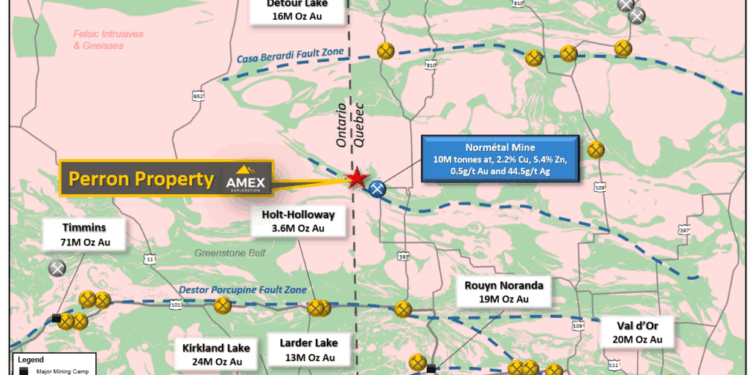Amex Exploration Inc. (TSXV: AMX) (FSE: MX0) (OTCQX: AMXEF) has received results from 58 drill holes focused on new areas of gold mineralisation on the Perron project in Quebec.
The latest results are focused on a number of new discoveries of gold and copper as well as follow-up drilling on the previously announced 210 (February 17, 2021) and Alizee (January 25, 2021) Gold Zones.
These results represent regional exploration drilling as well as mineralisation identified up-hole during definition and expansion drilling of known gold zones on the Perron Project.
Executive Chairman, Jacques Trottier, said drilling resumed on January 3rd with eight drills currently operating across the Project with plans to expand to up to 11 drills during the winter months.
“The Perron project has historically shown a strong gold signature within the Beaupre Rhyolite Block,” Mr Trottier said.
“The results presented today further validate the gold potential of the entire Beaupre area and we are seeing gold mineralisation occurring in a variety of orientation and mineralization styles. This further confirms our expectations that as we continue to advance our exploration of this strongly endowed gold system, we will continue to make additional gold discoveries and expand upon the known mineralized horizons.
“The E2 Gold zone is of great significance for Amex as it has the potential to add ounces per vertical metre in close proximity to the High Grade Zone. As we have seen at the High Grade Zone we are hopeful that the strike and grade will increase at E2 as we get deeper into the system. Our regional exploration programme has been a complete success by any measure and the areas highlighted in this release all warrant follow-up work.”
E2 Gold Zone
The E2 Gold zone (“E2”) represents one of the most significant new discoveries on the Perron Project since the discovery of the High Grade Zone (HGZ) in 2018.
The E2 zone was discovered by stepping out to the East along the same structure that hosts the bonanza mineralization of the HGZ. Mineralisation identified to date is very similar to the HGZ, with a repetition of a mineralized hanging wall vein, a largely unmineralised narrow mafic sill, and a mineralized footwall vein.
Sulphide minerals are also very similar, with sphalerite being the most common sulphide associated with gold mineralisation, along with lesser pyrite. Visible gold has been identified in several drillholes.
Of particular importance is the projected plunge of the mineralisation. The E2 zone is situated approximately 500 metres to the East of the HGZ, and the projected plunge of mineralsation (based on drillholes to date) appears to be similar to that of the HGZ, plunging to the East-Northeast at approximately ~70 degrees.
Amex said this is important as it represents a possible repeating ore shoot along the same structure as the HGZ. Expanding upon the E2 zone and testing its down-plunge grade and continuity is one of Amex’s top priorities for the ongoing winter drilling programme.
Gold-Copper Donna Zone
The Gold-Copper Donna Zone discovery occurs immediately north of the HGZ at depth. It was discovered during deep expansion drilling of the HGZ. The mineralisation identified, which is similar in each of the three holes reported, consists of highly chlorite-garnet-amphibole altered rhyolite which hosts centimetre-scale stringers of chalcopyrite-pyrrhotite.
The correlation between gold and copper is quite strong. Amex has completed a borehole electromagnetic survey on this new discovery and is planning follow-up drilling to be completed in the coming months.
For further information please visit: https://www.amexexploration.com/












